Andrew Paul Wood – 15 December, 2009
There are lots of other magnificent and significant works to choose from, including Michael Parekowhai's well known sculpture of the seal balancing a Duchamp on its nose, a magnificent Killeen and everything else you might (or might not) expect.
Earlier in 2009 Christchurch Art Gallery initiated a Dunkirk-scale reconfiguration and redistribution of its long-term collection displays. This is now open under the title Brought to Light: A New View of the Collection. There has been much rummaging and rifling of store rooms and Solander boxes.
The re-hang begins at the top of CAG’s magnificent Mussolini-esque staircase with a wonderful proscenium installation by Joanna Langford. Up from the Plainlands (2009) is a sort of Dr Seuss-like landscape of Astroturf supported by toothpick-like scaffolding, connected by a suspended miniature stairway to heaven - the heaven consisting of inflated cumulonimbus made of plastic shopping bags that reinvent the Baroque festoon. It looks fantastic.
This welcomes us to the upstairs landing and two vitrines of twentieth century and contemporary ceramics, at a cursory glance (not really my thing) mostly of the Bernard Leach and Shoji Hamada school, and from the hands of the usual suspects - Len Castle etc. One does wonder if art galleries are the best place for ceramics - the effect, especially crowded in as they are, is a little like the duty free mall in Hong Kong airport - but that’s just a personal belief on my part that such things are better kept in context with craft and social history of the museum.
Thence into the space proper. Gone is the more elaborate set of divisions - the carefully mediated chronological labyrinth of yore - in favour of more open (with considerably higher walls), more flexible, and above all, more eclectic open-plan spaces (with themes likely inspired by Michael Dunn’s histories of New Zealand painting and sculpture) beginning with “The Treasures of Ngai Tahu from the World of Light“, a celebration of tangata whenua. This is dominated by a safe but still hauntingly beautiful choice in Fiona Pardington’s Mauria mai, tono ano - a Becher-like catalogue series of black and white photographs of hei tiki from the collection of Auckland Museum. Much to my amazement, the CAG collection’s has no early portraits of Ngai Tahu, and the gallery has borrowed in a striking 1855 portrait of an unidentified Ngai Tahu subject by Charles Haubroe from Canterbury Museum, and some Gottfried Lindauer oils. While the Lindauers are taonga because of their ancestral subjects, I can’t say I really understand the widespread admiration for his rather naïf tea-and-beetroot stiff pseudo-academic style.
The “Connoisseurs’ Room” (a pretentious title blowing smoke up collectors and donors, living and deceased) is a salon-style hang where old masters like Gerrit Dou’s 1663 Piskijken, (a ‘physician’ studying a young girl’s urine for signs of love-sickness or pregnancy, a common motif in Dutch Golden Age genre painting) rub shoulders with Steve Carr’s A Shot in the Dark (Bear Rug) of 2008, which is a wooden carving of an old bearskin rug on a low plinth - possibly the most badly-judged juxtaposition since little tambourine-banging Sandi Thom sang “I Wish I Was A Punk Rocker (With Flowers In My Hair).” Personally I don’t like this kind of PoMo anachronistic shuffle in my exhibition experiences for the same reason NASA launched the Hubble telescope into space - less local interference.
I greatly enjoyed the section “Expatriates: Comings and Goings” particularly for the extensive hangs of Sydney Lough Thompson and Raymond McIntyre (as well as Owen Merton, Margaret Stoddard, Frances Hodgkins, Archibald Nicoll, John Weeks, Rhona Haszard and Olivia Spencer Bower, many of whom are still not well known in the North Island). I do think, however, they should have been separated from the influential immigrants (well, really the instigators of professional art in NZ) Van der Velden, Nerli and Nairn. Any mention of Nerli, of course, must lead us to his best-known pupil. Fanny Hodgkins again, this time with her own section, and rightly so, with pride of place going to The Pleasure Garden famously rejected by the Christchurch City Council in 1948 when offered to the gallery as a gift by a group of private subscribers. Hodgkins by this date enjoyed an extraordinarily high reputation in Britain and Europe. All right, I realise that Fanny remains the most internationally important artist New Zealand has ever produced, but I’m not sure she warrants all this attention - more so than say McCahon, Fomison or Sutton, who have arguably more connection to Canterbury.
Another large space is given over to a magnificent (good for being representative, but by no means exceptional) Bill Culbert installation Pacific Flotsam (2007) created from fluorescent tubes like pick-up sticks, and plastic bottles - a reference to the Great Pacific Garbage Patch, a USA-sized Sargasso of trash in the middle of the ocean. Much of the impact comes from the sheer heroic scale of the beast - a massive luminous crystal that also manages to highlight the accidental and imperishable beauty of the twentieth century’s detritus. The effect is awesome.
I was delighted to see four Theo Schoon paintings of Maori “moa hunter” rock drawings on loan from a private collection in the hang. Last time I had seen these sketches on cardboard, they had looked a lot worse for wear with battered corners. Presented in stylish black frames they really come to life and pop off the wall.
Inevitably, particularly giving Canterbury’s strong regional resources and CAG’s limited holdings, a menu touristique of sorts prevails. This impression is even stronger in the late modern and contemporary sections - but then as an educational tool the encyclopaedism is priceless: an exquisite Pat Hanly is positioned next to a superlative (Frankenthalerish) Gretchen Albrecht. Works by Clairmont, Fomison, Trusttum illustrate the phase of neo-expressionism inspired by Rudi Gopas. There are some very nice international pieces as well - I was particularly taken by the pop tarts Warhol (a big blue Mao like an overripe plum after a Long March) and a little Lichtenstein.
The contemporary space has plenty of room for installations - woof! Banzai! Mazel Tov! - with perhaps, dare I say it, a slightly Govett-Brewsterish feeling to it. But why not a section on contemporary Canterbury painting to complement the historical sections? And why is that Julian Dashper so high up on the wall? I get a crick in my neck. Things don’t feel quite so structured here. Colour is far more dominant than in the previous hang. There is a rich trove of stuff here, including a lovely Ann Shelton diptych, some truly delightful Paul Johns works and Frances Upritchard baboon (one of a pair, the other being in the summer kiddie show Blue Planet at the other end of the wavy bridge). There are lots of other magnificent and significant works to choose from, including Michael Parekowhai’s well known sculpture of the seal balancing a Duchamp on its nose, a magnificent Killeen and everything else you might (or might not) expect.
Now I am well known for thinking John Reynolds’ recent habit of doodling lexical scrawls on miniature canvasses is a load of lazy conceptual tosh, but although I am by no means won over by Table of Dynasties dominating the far end of the contemporary space - I find it at least visually a whole lot less offensive to my sensibilities than much of his other work (especially the colossal dud that got him nominated for the 2008 Walters Prize). Regardless, it is still intellectually void, queerly mounted, and I am reminded of the Balzac story “The Unknown Masterpiece” in which the master painter Frenhofer works and reworks a painting for a decade in his obsession to make “the most complete representation of reality”. When two fellow artists are permitted to view the finished canvas, they see only a confused blizzard of piled up random colours and forms. “Ah!” says Frenhofer, misunderstanding their shock, “You did not anticipate such perfection?”
On the whole I am really pleased with the result. I like it that the layout is less claustrophobic and serpentine - now you can more-or-less see from one end to the other without worrying about leaving a trail of breadcrumbs or being pounced on by a minotaur. The curators have managed to balance the familiar favourite icons of the local burghers with a fresh batch of material for the genuine art lovers to ogle. Finally we also get to see some of the collection purchases made in the last few years, and research artefacts we have never seen before. It’s also good to see art galleries working closely with museums - it’s the only way the other centres and regions have any chance of competing with the apocalyptic behemoth of Te Papa. All in all, I give it an A-.
Photos courtesy Christchurch Art Gallery / John Collie
Andrew Paul Wood
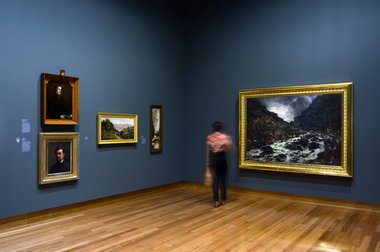
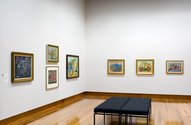
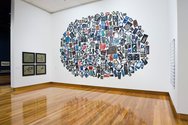

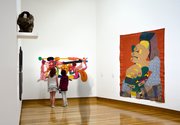
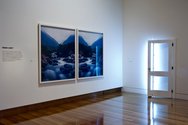
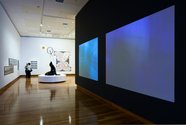
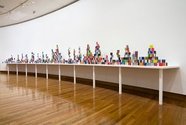
 Advertising in this column
Advertising in this column Two Rooms presents a program of residencies and projects
Two Rooms presents a program of residencies and projects



This Discussion has 0 comments.
Comment
Participate
Register to Participate.
Sign in
Sign in to an existing account.